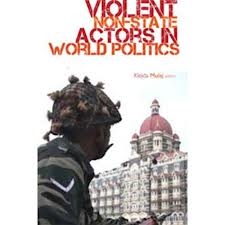|
Reviewed by Daveed Gartenstein-Ross, Ph.D. Candidate at the Catholic University of America Klejda Mulaj notes in her introduction to this volume, violent non-state actors (VNSAs) “have only recently received sustained interest amongst academic and policy circles” (1). In part because this field of study is so new, the academic understanding of VNSAs remains theoretically underdeveloped. Yet it is also a vital field. Not only has the past decade in national security been defined, at least for the United States, by the “global war on terror,” but also a number of structural factors-including the coming era of austerity, resource scarcity, and technological empowerment of non-state actors at the expense of the state-promise to make VNSAs grow in importance. This is not to say that VNSAs will continue to be the top security concern of the United States and other Western countries, as al Qaeda was for the decade following the 9/11 attacks, but rather that these actors will likely be increasingly capable of challenging the nation-state at a strategic level. Violent Non-State Actors in World Politics is designed to advance our understanding of VNSAs; and it succeeds in doing so, although falls short of what it could have been with a heavier editorial hand. The volume begins with an erudite and sweeping introduction from Mulaj that is one of the book’s more informative entries. Mulaj begins by defining VNSAs at length. Some of her inclusions are obvious-national liberation movements confronting an occupying force, insurgent guerrillas that wish to weaken or destroy a ruling government, terrorist groups, and militants that include warlords and paramilitary adjuncts-but, satisfyingly, she also includes mercenary militias (e.g. private military firms) in her definition. Indeed, private military firms constitute an important VNSA, often overlooked by students of the changing geopolitical landscape, that typifies many of the overarching trends in twenty-first century conflict. Mulaj correctly notes that “the wide range of contemporary VNSAs renders it impossible to offer a general conclusion that VNSAs are either ‘good’ or ‘evil'” (6). Wide variegations exist amongst them. Some oppose the status quo, and some support it; some are driven by ideology, and some are not; some kill indiscriminately, and some are selective in their choice of targets. Further, VNSAs are in important ways defined relative to the state. Sometimes, when a state is failing in a country’s periphery-unable, for example, to provide basic services-there may arise a “fragmented sovereignty,” where “state and non-state actors interact, coexist, cooperate, or conflict tacitly and implicitly” (7). In other cases, VNSAs may be co-opted by the state-for example, in pre-partition Sudan, where VNSAs became “central to the exercise of state power” (9). Given that VNSAs may out-compete the state in areas where the state is theoretically the sovereign power, it is unsurprising that Mulaj turns next to what she dubs “the puzzle of legitimation.” Though political scientists commonly assume that states enjoy a monopoly over the legitimate use of force, in some instances-such as civil wars or revolutions-there is simply “no clear way of deciding which authority makes the most legitimate claim” (15). This is, of course, a prescient point-one that, subsequent to Mulaj penning her introduction, played out in Libya, and is currently vividly illustrated in Syria. (Neither the successful revolution in Tunisia nor the overthrow of Hosni Mubarak in Egypt involved VNSAs, but instead both were nonviolent in execution.) In bothLibya and Syria, the U.S. determined that the “sovereign” government was, in fact, less legitimate than the opposition, and intervened (to a greater or lesser extent) on behalf of this opposition. In her observations about legitimation, Mulaj isolated critical factors that would be intimately related to the success or failure of the Arab revolutions that captured the world’s attention soon after her volume was published. One factor she pointed to was the government’s “disproportionate and indiscriminate force in counterinsurgency tactics”: indeed, Muammar Qaddafi’s over-the-top threats against Benghazi helped spark NATO’s intervention in Libya against his regime, while Bashar al Assad’s bloodthirsty tactics have steadily eroded already waning perceptions of the Syrian regime’s legitimacy. Another factor she highlighted was the impact of globalization, and in particular the globalization of the media, on questioning the legitimacy of states’ internal use of force. (Think of the “Al Jazeera effect” and its role in the Arab revolutions.) Unfortunately, the book falls short of the early promise so evident in this introduction, though it does feature a number of strong chapters. Some of the more noteworthy contributions include Nazih Richani’s theoretically rich chapter on VNSAs in Colombia; Ignacio Sánchez-Cuenca’s contribution on the Euskadi ta Askatasuna (ETA) Basque nationalist terrorist group, which helps remedy the dearth of English-language material on this organization; and Ken Menkhaus’s characteristically informed and cogent essay on VNSAs in Somalia since the collapse of the state. Just as Mulaj’s introduction is particularly interesting in light of the Arab revolutions that occurred after she wrote it, so, too, is Hassanein Tawfik Ibrahim’s chapter, “The Rise and Fall of Militant Islamic Groups in Egypt.” Ibrahim’s description of the factors that led to the marginalization of Egyptian militant Islamic groups (MIGs) might lead one to wonder if they now could be poised for a significant re-emergence. He notes that three components of the Mubarak regime’s strategy were most critical to defeating MIGs. First, the regime developed a security confrontation strategy consisting of intelligence collection, powerful strikes against the Jihad Organization and Islamic Group, and a clampdown on their sources of funding. Second, the government actively removed extreme religious ideas from institutions of the state: the Ministry of Education “removed hundreds of teachers with radical ideas who were trying to spread their views among schoolchildren,” while the Ministry of Endowments brought “thousands of mosques under its control and supervision” (132). Third, Egyptian officials focused on more effectively controlling the country’s borders to prevent MIGs from receiving outside assistance. Will these policies continue in the post-Mubarak era? Though Ibrahim certainly did not know of the wrenching changes to come, his chapter provides an excellent guide to what kind of changes in Egypt might allow MIGs to recover as a powerful force for violence. Other chapters are weaker. For example, Eric Herring’s contribution on armed groups in Iraq includes an extended theoretical framework explaining neoliberalism’s centrality to non-state violence within the country. Following the American invasion, Herring notes, most of the country’s population have ended up “marginalized, consuming minimally, uninsured, but policed and if necessary repressed,” while some portion of the country’s elites have become “part of the global North-deeply integrated into advanced capitalism, wealthy, and benefiting from containment and securitization of the global South” (185). This is an interesting framework that, if substantiated, could provide a significantly different perspective on conflict within Iraq than analysts have commonly possessed. The problem is that Herring’s examination of VNSAs in Iraq-groups like al-Qaeda in Iraq, the Mahdi Army, the Reform and Jihad Front, the Kurdistan Free Life Party (PEJAK), and the Kurdistan Workers Party (PKK)-is quite conventional, in line with work that analysts have previously undertaken, and completely unrelated to both neoliberalism and globalization. This means that not only has Herring not proven his theoretical framework trumpeting neoliberalism’s centrality, but also that he doesn’t really provide evidence for it in the substantive portion of his chapter. Overall, though, this book’s major flaw is not the variable quality of its chapters, but the fact that it lacks an overarching framework. Mulaj’s introduction brilliantly outlines the current state of knowledge about VNSAs, and explains a number of crucial questions about their role in world politics. These questions include the conditions that produce VNSAs, how the state impacts their emergence, at what point non-state actors “consider violence useful for their purposes,” the ways in which violence changes “the nature and purpose of relations between VNSAs and the state,” and how external parties can “impact on the evolution and operationality of various violent non-state actors” (2-3). The contributions to Violent Non-State Actors in World Politics do examine these questions, but each through its own varied methodological lens, with little discussion of how its own framework compares to other ways that scholars evaluate VNSAs. For an emerging field such as this, a heavier editorial hand on Mulaj’s part could have ensured that the book not only made substantive contributions-something that it does accomplish-but also helped the reader to understand how this academic field of study is advancing, and grappling toward a better comprehension of the subject matter. (One book that does an exemplary job in this regard, which I also reviewed for ASMEA, is Owen Greene and Nicholas Marsh’s Small Arms, Crime and Conflict.) If the chapters had shed more theoretical light on this developing field, then this book could have fulfilled the promise that was so evident in Mulaj’s introduction. |


 Violent Non-State Actors in World Politics
Violent Non-State Actors in World Politics

